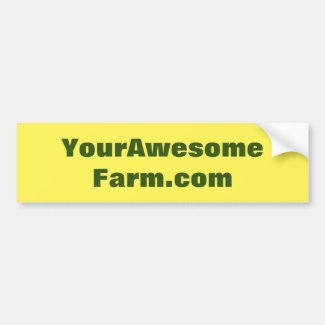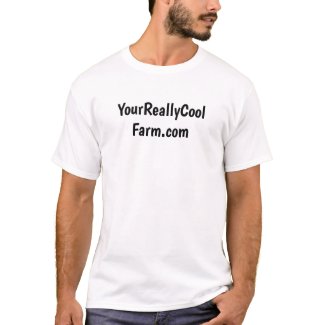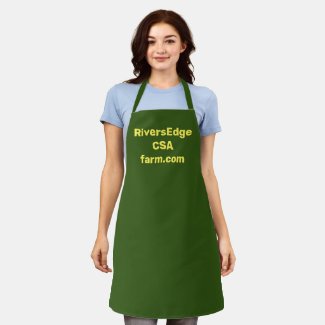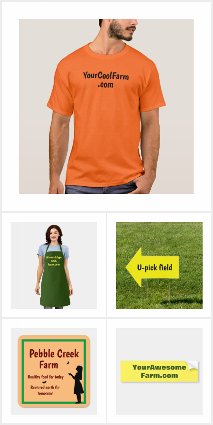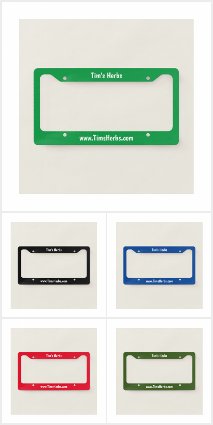Marketing farm products and promoting your local farm's name or brand
Copyright National Lilac Publishing, LLC
This article is for both those just starting their exploration of farm promotion, as well as those seasoned but looking to fill gaps in their system.
First, be aware there may be new and returning customers to consider
When choosing promotional techniques, consider that you may be attracting new customers as well as keeping past ones loyal and interested in your farm. Many promotional techniques will generate both types of customers, while some are more appropriate for one than the other. Know which type of customers you’re looking for. Do you actually have a waiting list for your CSA, and prefer to concentrate on keeping the good customers you have? One U-pick blueberry farmer transitioned from attracting huge numbers of the general public each year, to maintaining a smaller number of loyal returning customers through a farm membership similar to a CSA.
Or instead, are past customer numbers dwindling, or is the farm so new it has few or no customers at all? In those cases, perhaps it's time to get the word out to the general population to find new customers.
Consider a single $6 farm bumper sticker...
...as a low-key, incredibly simple method for seeking new customers. Or, an $8 removable window cling if you prefer. You've seen business vehicles sporting the business name on the vehicle, promoting their businesses everywhere they drive. There are even ad agencies that pay everyday drivers up to hundreds of dollars a month just to put ads on their vehicles and drive their regular routes. They know this works.
So on a smaller scale, you’ve also seen bumper stickers promoting
businesses, points of view and travel destinations. You can join in with a bumper sticker sharing your farm's website everywhere you drive with your own vehicle. Hand make one or order a create-your-own bumper sticker from a print on demand store like our Zazzle affiliate linked above.
That's the simplest phase of bumper sticker farm marketing.
The second phase is making
several bumper stickers, and asking friends and relatives to put one on their vehicle. (Be careful and choose wisely. Maintaining good family and friendship relations is more important than forcing our business promotion onto others in our circle. Some people just don't like putting stickers on their cars... or perhaps don't have room for more than what they already have.)
The third phase is printing a few more and giving them away to certain current customers who seem happy to help you promote the farm. When giving them away for non-farmers to display, you may want something more catchy that doesn't make people think your customers are the owner of the farm when the bumper sticker is seen on their vehicle. Something like “I shop at Grapehill Farm." Once again, customer comfort is very important. Avoid pressuring people to have this bumper sticker on their car, thinking you'll be checking up on them when they pull in to greet you and pick up their CSA or harvest at your U-pick.
Removable vinyl clings may be a better choice for the above purposes. Make sure your words are printed on a solid white or light colored background instead of a transparent one. Otherwise, it's hard to see the words with the background of the vehicle seen through the transparent cling.
Actually selling customized bumper stickers or clings to your customers vs. giving a handful away to a few family members, friends and/or customers, may be best for larger agritourism farms where guests want to show off their travels -- "I’ve Fed Sheep on Grapehill Farm, Ashland, Oregon."
Wearing your own farm T-shirts and other products that promote your farm
Along the same lines as a bumper sticker, the more potential customers see the name www.MyAwesomeFarm.com, the more new customers can remember and eventually find you.
Why not use trips to the grocery store or other errands around town to effortlessly double as ways to lead people to your farm's website.
You may know a local artist who can screen print your words or design onto cloth items like t-shirts and totes. But, there are DIY methods to make a small number of beautiful customized T-shirts yourself. If you can lightly transfer the outline of your farm's logo or website onto a white T-shirt with a Frixion or other removable pen, perhaps by holding the shirt and image up on a well lit window, you can then strengthen the look of the outline and fill in the spaces with permanent fabric markers.
Another homemade option: Scan or type your own words and images and print them onto iron-on transfer paper paper meant for fabric.
You may be interested in customizing a single hat, T-shirt, mug (tote, jacket) at our Zazzle affiliate if you understand its design tool.
If not, we've set up a few easier templates here of various products like T-shirts, license plate frames, bumper stickers, removable vinyl clings, etc., that make it less complicated to personalize without having to use the more complex design tool.
Attract the media
Numerous successful farms that cater to the local community insist articles in local papers do more to draw quality customers than any advertisement one could possibly pay for. They also make current loyal customers proud to have already discovered you. My own experience with this is that when they spell your name wrong, don’t quite quote you correctly, and mistake goslings for ducklings, it still works! People love to witness what the actual professional media has reported.
In today's world of some professional media outlets polarizing into more like political opinion outlets than objective reporting, and of everyone else with a cell phone and social media accounts playing amateur reporter, it can be a double-edged sword regarding whether they depict you fairly, unbiasly, and accurately as trained journalists are supposed to do. But even in the blogging and social media realm, there are people with quality online pages sites and a decent following you may want to contact about sharing your story or link.
Popular foodie bloggers, environmentalists, locavore advocates and those who love and blog about rural living traditions may be interesting in a story about you for their audience. Hunt around online for lists of the best bloggers on topics that may be a good fit.
As far as the professional local and regional media, sometimes old fashioned press releases still work. There are many tutorials online on how to create and present one. Be careful of services that promise to get your online press release to thousands of news media outlets for a fee. Those press release mills may not target the right people and their e-mail announcements to the media may be discarded by the media without even opening them. The best way may be to send out physical print press releases to your local newspapers, TV station and radio station every few months or so, each time with a different angle. Even farms trying to reach a more distant audience can benefit from local media attention because larger publications scan the smaller ones for interesting news and prospects to flesh out their human interest and other stories.
Destination farms have found themselves listed in European travel guides with no idea how they were initially discovered, but now happily book numerous Europeans and find themselves filled through August as early as January or February.
The farm open house or one-time festival
A one-time or occasional on-farm event can also attract the media, generate word-of-mouth promotion (very valuable), and be a direct sales outlet on the day of the event. “We can't say enough about open houses and farm days,” said John Ivanko and Lisa Kivirist, co-authors of Rural Renaissance and owners of Inn Serendipity, a bed and breakfast farmstay experience in Wisconsin, USA. “It's a great opportunity to form relationships with current and future customers, or in our case, B&B guests. We have one near July 4th, celebrating ‘energy independence day.’”
The Farm’s open house can be as simple as letting people bring their own picnic to enjoy the farm for an afternoon, or an herb preserving demonstration. The event itself, of course, will need promotion to attract visitors, proper permits and safety measures followed. But once the event occurs, it may end up being the most valuable promotional tool of all.
Print fliers
Even in the world of online announcements, for one-time or seasonal events, some farmers have benefited from printing up fliers to be displayed in the towns where their customers live. The owners of Sweet Grass Dairy in Thomasville, Georgia USA hold two open houses in spring and fall called Market Day that attract many visitors to their grass-fed dairy. Co-owner Jessica Little stated that one of their methods for drawing customers includes having their local printer create posters announcing the event, which they put up around town (with proper permission, of course) before Market Day.
Another
pumpkin grower received a good turn-out for their one-day only U-pick
pumpkin patch by getting permission from their local elementary school
to send fliers home with their own kids' classroom students.
If interested in trying out fliers or larger posters, get to know all the locations near you that allow quality fliers or posters to be displayed before investing time and money in making them, and think about having a graphic design inclined friend design it for you, making sure the basics below are covered. We’ve seen beautiful printed fliers that hark of a fantastic upcoming event…. with no address listed and no contact information for finding out where it was!
Another
time, a grower we knew put a flier out for an apple U-pick day on the
farm. It mentioned nothing about any cost or fee. A family showed up
first thing, picked apples, then left without paying, saying how nice it
was of the farmer to give apples away.
Include:
- A
short catch phrase in large, bold, easy-to-read letters (don’t get
wispy or flowery with the lettering here). You should be able to read it
10 to 15 feet away with 20/20 vision.
- In smaller lettering, list all other relevant information: date, time, fees, location, contact for more information. Use very few words for this list. Your audience is passersby, who may keep on walking if they see too many words in their world of far too many words everywhere. This list would be the most effective and attractive to the eye if it were bulleted.
- An attractive image of the farm, of flowers, of pumpkins. This can be almost as important, if not more so, than the catch phrase. It also should be visible from a distance.
- Have a good speller who didn’t design it do a final proofreading.
- Usually,
putting it up two weeks before the event is ideal. One week may not
give people enough time to plan or enough time for more folks to see it.
- Remove them when the event is over especially if you want those who were kind enough to let you use their space for free advertising to let you put fliers up again in the future.
Brochures and business cards
Printed
brochures, of course, are giving way to online promotion as a tree-friendly, less expensive, and a
more far-reaching form of ongoing marketing. But many still like to carry
business cards with them, and you may choose to overlap and use both brochures
plus business cards along with online marketing now and then, making sure your
website is on your brochure and business cards. The brochure tends to be
adequate for describing the farm year-round, where as the flier is for a
one-time situation. Places for permanent print brochure locations could be your
local Chamber of Commerce (check for their size and other
requirements).
Online marketing
Whether it's a single page on a free web hosting service, a WordPress blog, or an empire of social media accounts, most know by now how important it is to have an online presence of some sort that people can go to for more information and contact. But it bears repeating. Jane Eckert, of Eckert AgriMarketing in St. Louis, Missouri, has stated that online marketing is of utmost importance to farm marketing today. There are always exceptions, as with the occasional farmer that finds a niche supported without it and doesn’t even own a telephone. But most will want to consider the advantages of a website. “Online marketing opens new doors for farms, and customers are eager to shop this way,” Jane said. “Approximately 75% of North Americans use the Internet to plan their family and business trips; to find entertainment, wineries, hunting trips, family experiences; and to purchase fresh farm products. Even if farmers perhaps aren’t that familiar with the Internet, they must recognize that most of their customers are - and today's consumers rely on the Internet as their primary source of information.”
The basic need is a farm website that’s kept fresh and up to date. Added elements can include the online farm journal via a blog which helps retain current customers (see below), and various methods such as social media pages and local physical promotion for helping potential new customers discover your website. Some farmers have traded web services for CSA shares, and a savvy computer person can find ways to trade links with other quality websites, along with other ways to lead new customers to your farm’s site.
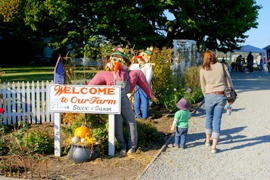
Signs and... scarecrows?
A farm sign, whether permanent or temporary, can alert people to your location, create a gateway between the farming and non-farming world, and draw the attention and curiosity of passersby. Farms are often also private homes, and visitors can feel they are welcomed rather than intruding when a sign officially announces the farm that's open to farm visitors. If you give the occasional, casual farm tour and otherwise don't want drop-ins, an A-frame (the kind and size real estate agents set out for open houses) or otherwise portable sign may suit your needs.
Another portable and temporary sign: More than once, we've seen clever scarecrows used with, or as, signs. Sometimes they're set up near separate signs or appear to be holding signs. In other cases, they're actually the sign itself by wearing shirts with letters, and set up near the road or entry way as an eye-catching and memorable temporary sign. We have a scarecrow article on that here.
If drawing the attention of
the general public is inadvisable for your privacy and safety, you may
choose to forgo an official permanent or even temporary farm sign of course. Some farmers are content to keep their property relatively unknown, and sell online by mail and delivery instead.
Networking with Larger Entities
It can be profitable to network with larger entities created to help promote ecotourism. It can also be dangerous, or at least, a waste of money.
“Larger
entities” worth considering include citizen groups, especially other farmers, specifically formed to promote and
support local farms, local Chambers of Commerce, agriculture extension
groups, shared interest groups such as sustainable living organizations,
and businesses set up to lead tourists to attractions by geographical
area. Be a little cautious with that last one. They can sometimes come across as "helping the farmer" when they are actually exploiting the farmer for their own gain. A little more on that below.
Other networking entities may also include those with which you create packages with other businesses such as hotels, giving their customers a discount at your farm tours for a payback to you by the hotel. Or, it could mean looking into all other events that already happen in your area, and joining them, allowing your farm to be a segment of those events, such as being a stop-off point for an annual bicycling event.
As far as tourist promotional groups and listing directories, these may charge a fee to list you, or may want a percentage of your revenue, depending on your country and theirs.
A main thing to watch out for is whether the entity really wants to make their relationship with you mutually beneficial, or simply wants to take a possibly too large percentage off the top of the fees you charge guests without doing much authentic promotion beyond a quick directory listing. You, then, are still stuck doing most of the promotion while they take their slice. In some other countries, there is the problem of local traditional farmers being promoted as tourist attractions by large tourist entities, without any consent from the farmers, and without any method for the farmers themselves to receive added revenue from the tourists they draw in.
And as eco and regenerative farming becomes more mainstream, hold your ground and make wise decisions when non-farming "entrepreneurs" believe it's the next new trend they can monotize, and they try to become your promotional experts without understanding how eco and regen actually work. If they can first prove their worth to you, perhaps they can serve you. If they don't earn your approval, perhaps not. And you're hopefully never to be one of their many lower level cogs in a money earning machine they're trying to build that sweeps past the depths and intelligence of what eco and regen ag really are. There's money in greenwashing, and they may see you with dollars in their eyes but not in yours.
Also, be aware of restrictions that are too high for you to
meet. AirB&B and other bed and breakfast listing and promotional organizations, for example,
understandably need to make sure the B&Bs they endorse are safe and
that the B&B is operated legally, in order to maintain their own
reputations, which in turn, allows them to stay successfully in
business. But their restrictions may be too stiff for your perfectly
legal and enjoyable B&B farmstay. If they require private bathrooms
and you offer a rustic outhouse, you may find that marketing
independently will serve you better.
The Farm Journal
The farm journal can be in the form of a monthly print newsletter (very rare these days), an online blog or e-newsletter, or a combination. Both men and women farmers of the past used to keep journals and written logs, it’s a natural part of farming for many. If journaling is for you, consider using a version that’s appropriate for others to read as a marketing tool.
It’s the realness, and the uniqueness, of who you are that cannot be duplicated by theme parks, slick ads, and cannot be copied and offered for less by a competitor. No one can describe the first crops that push up from your soil, complain about the unexpected hail storm, share excitement about the new peach variety, the way you can. Let your guests live vicariously through you. A farm journal can both maintain current customer loyalty and attract new customers when its print or online version is passed around.
Some farmers and aspiring wannabe farmers, have gone a step further and set up online video blogs (vlogs). You might be interested in our article on farmers using YouTube for this purpose.
Paid Advertising
There are books, trade magazines, in fact entire university degrees catering to the benefits, pitfalls and skills needed to make paid advertising in print, radio, online and TV media effective. We won’t elaborate too much for this article. But do know that the reason news articles, for example, have more draw to customers than paid advertising is their believability and trust. The media is supposed to give unbiased reports and is therefore more trusted by the public. (Certainly arguable regarding how many actually follow those traditional rules.) Ads, most people know, are meant to say only the good things, and leave out the rest. People don’t trust paid ads as much as they do other forms of communication such as news media in spite of its possible biases, word of mouth, or going in person to the farm.
However,
a classy paid advertisement can sometimes pay off. There are two basic
types in print. The ads that take up space, say four inches by four
inches on a newspaper page, or the full back page of a magazine, are
often called space ads. The other choice, as most know about, is the
classified ads. Less popular now, but still effective in some locations.
If you are trying to draw customers of a certain location or shared interest group on an ongoing basis, and you know of a reputable publication that reaches this audience, a simple repeated space ad may help keep your farm’s name in the public eye. If you’re having a one-time farm event, and you feel that it may appeal to those who love to cruise classified ads (bargain hunters or those seeking special events), a classified ad may be well worth its much lower cost.
But if you plan to get deep into paid advertising, we strongly suggest you learn more about how to target such ads, and how to keep track of their cost effectiveness over time. Also, learn to talk shop with fast-talking advertising salespeople. For example, newspapers can put your ads in the least desirable location. Ask what your options are as far as where your ad will be placed. If you have no control over where it’s put, and there’s a chance it will be stuck in a rarely read location, or a location that doesn’t draw the type of reader who would be interested in your farm, you may want to tell the salesperson you’d rather do other forms of promotion than risk purchasing space from his or her newspaper.
As another example, if a reporter is doing an article related to your farm’s theme, perhaps even an article on your farm itself, you may be suddenly approached by the paper’s sales staff, with stiff deadlines, to put an ad in at the same time the article will appear. Consider this very carefully. In what way would a paid advertisement benefit the promotion you’ll already receive from the article? Would it actually look better for you to be presented only in article format? Would your advertising budget do better to allow the article to promote you for free, with, perhaps, a follow-up ad in the next edition? If you feel you’d rather not purchase an ad on top of the news already being presented about you, you may want to tell the salesperson that your advertising budget has already been allocated for the year, and if the article about you appears to attract a good enough audience, you’ll consider them in your budget next year after carefully, without pressure, assessing their information regarding readership numbers, advertising prices, and choices for ad location.
Promoting with Customer Word of Mouth
Customer feedback should do three things to boost your business. First, it should tell in what way you’ve made your customers happy, so you know what to continue or expand on. Second, it should also tell you where you really screwed up. The six-foot tall gory monster that chased the screaming preschoolers out the door in the haunted barn at a farmer's Halloween farm open house was just plain stupid. By using the negative feedback to tweak the product or find a different audience (such as teenagers who love to be scared by six-foot gory monsters) the farmer becomes smart again… unless he was actually illegal or harmfully negligent).
Third, the positive
feelings of your farm customers can also work for you in the promotional
department by generating some of the best promotion money can’t buy:
word-of-mouth.
In
fact, it can be used even before you’ve decided exactly what your
direct marketing venture will be. New business owners sometimes use a
strategy where they contact potential customers even before any product is created. For farmers in the planning stage or those looking to add new crops or value-added products, this strategy might be worth considering. A
list of possible customers is drawn up. A detailed description of the
potential product or service is written up, and then it’s sent out to
the possible customers for their feedback. The reasoning is that most of
these hypothetical “customers” will give both positive and negative
feedback. With the negative feedback, the product is tweaked and
streamlined ahead of the actual product, and the description or prototype is sent out again until a
desirable “can’t miss” product or service is developed.
This has worked for new agritourism ventures when the farms already had a list of potential customers, such as their long standing CSA members, and the on-farm project, such as an annual pumpkin patch, is in the planning stage. It can be very valuable to hear: “There are already too many corn mazes around here. How about a labyrinth instead?” Or, “I use your farm to expose my kids to something besides constant comparing and competition. Could there be a ‘pumpkin carving demonstration and gallery’ showcasing the kids’ pumpkins, instead of the usual pumpkin carving contest with only one winner or worse -- resorting to the "everyone gets a winning ribbon" issue?”
Then, if you choose to eventually test out an event or other on-farm marketing idea by first just giving it away when you plan to eventually charge for it, test it on a small chosen group that knows it will be charged a fee in the future. You don’t want word of mouth spreading the rumor of free tomato testings and corn given away daily your farm. Meaning, if you’re planning a small-scale cooking class, or an on-farm writers’ retreat for just a few customers at a time, offer it for free to a select small group that knows it’s a practice run to generate feedback and word-of-mouth.
There is at least one flaw in the idea of letting customers have too much say in what your on-farm project will be. People are so removed from nature, they may not even know how beautiful the experience of picking their own flowers from your U-pick flower patch can be. Customers truly might not know what they want, or might think a farm idea would be great from watching a Hollywood version of farmlife, then be shocked when it isn't what they expect. You may choose to balance the idea of allowing others to guide your choices, but also finding ways to get them to experience on-farm activities that eventually gets them hooked on something they hadn't tried or thought of before.
The above mentioned owners of Sweet Grass Dairy attracted people
to their farm in the first place to tour a dairy farm, and then later developed a
cheese-making class when visitors to their Market Day began requesting
them. When allowing customers onto your farm, be sure to set out a sheet
for comments, with an option for their name and contact information.
Ride Elevators… or at Least Think out of the Box
Gift baskets are value-added products some farmers are selling both direct from the farm and off. Here’s one person’s secret to marketing her gift baskets. She lived close enough to a large city where she hoped to generate customers. She built a beautiful basket and carried it to a busy high rise’s elevator, as though she were delivering the basket herself to someone in the building. All afternoon, she rode up and down the elevator, handing out business cards to the people who couldn’t help being enthralled by the beautiful basket. This is how she got her first initial customers, and grew from there.
Another farmer who delivered fresh produce weekly to her hometown restaurants started out showing up at the back door with the goods in various cardboard boxes. But then an idea struck her. She arranged the produce in a beautiful large basket tray, put on a clean T-shirt and long denim jumper dress, and entered the restaurant through the front doors instead, carrying the basket of colorful produce past the customers. It drew attention from the customers who saw the reality more clearly that this restaurant purchased from local growers, which helped the restaurant's word of mouth promotion, and she was able to hand out requested business cards to several customers interested in purchasing direct from her, all with permission from the restaurant owner, of course. Don't worry, guys, it can work great for you, also. Good personal hygiene, clean T-shirt, clean jeans, and let the world meet their farmer.
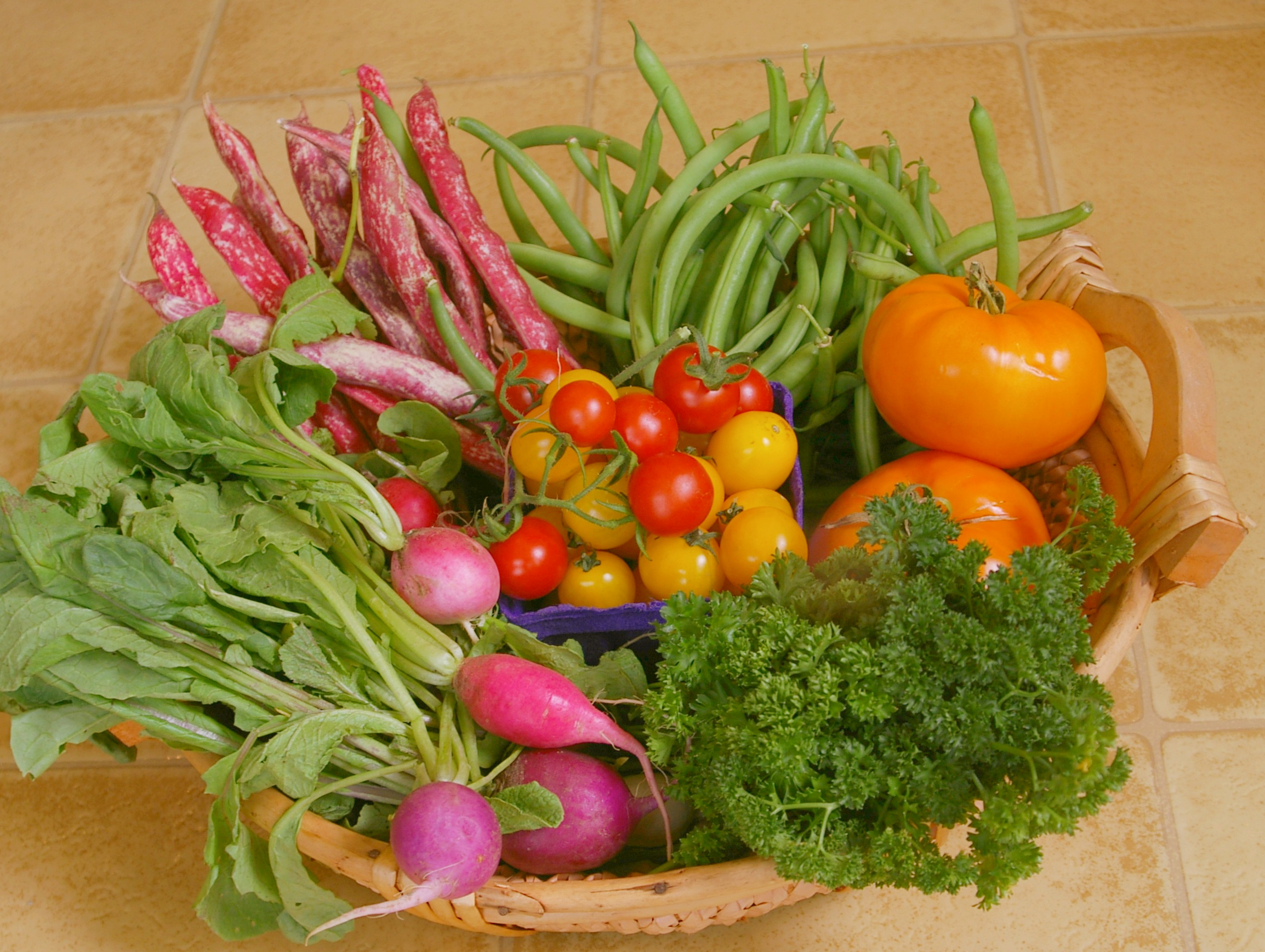
While there are conventional methods for marketing, many of which we’ve overviewed here, remember to think out of the box when it comes to generating promotion for your farm, and custom-fit it for the lifestyle you already live. Do your kids belong to a scout troupe? Could the troupe and its parents have a VIP tour with a sample product and farm brochure to kick-start word of mouth? Do you knit? Could a knitting gathering take place on the farm and therefore see what the farm is all about, generating future word of mouth interest? Are you involved in the local Audubon Society? Could they come to the farm for bird watching and spread the word about your organic orchard?
In one case, some ranchers' parents anniversary not only promoted their farm, but brought a new revenue source to the ranch. Tony and Carol Azevedo of Double T A-Cres in California held a 500 person anniversary party for their parents on their dairy ranch. It was just a private celebration. But afterwards, guests began calling to see if their own events could be held there, and since, they have earned substantial additional income from weddings and other events held on the farm.


